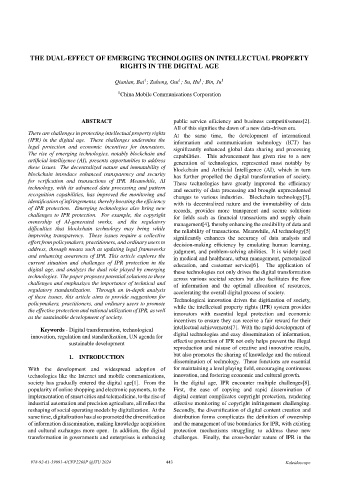Page 487 - Kaleidoscope Academic Conference Proceedings 2024
P. 487
THE DUAL-EFFECT OF EMERGING TECHNOLOGIES ON INTELLECTUAL PROPERTY
RIGHTS IN THE DIGITAL AGE
1
1
1
Qianlan, Bai ; Zuhong, Gui ; Su, Hu ; Bin, Ju 1
1
China Mobile Communications Corporation
ABSTRACT public service efficiency and business competitiveness[2].
All of this signifies the dawn of a new data-driven era.
There are challenges in protecting intellectual property rights
At the same time, the development of international
(IPR) in the digital age. These challenges undermine the
information and communication technology (ICT) has
legal protection and economic incentives for innovators.
significantly enhanced global data sharing and processing
The rise of emerging technologies, notably blockchain and
capabilities. This advancement has given rise to a new
artificial intelligence (AI), presents opportunities to address
generation of technologies, represented most notably by
these issues. The decentralized nature and immutability of
blockchain and Artificial Intelligence (AI), which in turn
blockchain introduce enhanced transparency and security
has further propelled the digital transformation of society.
for verification and transactions of IPR. Meanwhile, AI
These technologies have greatly improved the efficiency
technology, with its advanced data processing and pattern
and security of data processing and brought unprecedented
recognition capabilities, has improved the monitoring and
changes to various industries. Blockchain technology[3],
identification of infringements, thereby boosting the efficiency
with its decentralized nature and the immutability of data
of IPR protection. Emerging technologies also bring new
records, provides more transparent and secure solutions
challenges to IPR protection. For example, the copyright
for fields such as financial transactions and supply chain
ownership of AI-generated works, and the regulatory
management[4], thereby enhancing the credibility of data and
difficulties that blockchain technology may bring while
the reliability of transactions. Meanwhile, AI technology[5]
improving transparency. These issues require a collective
significantly enhances the accuracy of data analysis and
effort from policymakers, practitioners, and ordinary users to
decision-making efficiency by emulating human learning,
address, through means such as updating legal frameworks
judgment, and problem-solving abilities. It is widely used
and enhancing awareness of IPR. This article explores the
in medical and healthcare, urban management, personalized
current situation and challenges of IPR protection in the
education, and customer service[6]. The application of
digital age, and analyzes the dual role played by emerging
these technologies not only drives the digital transformation
technologies. The paper proposes potential solutions to these
across various societal sectors but also facilitates the flow
challenges and emphasizes the importance of technical and
of information and the optimal allocation of resources,
regulatory standardization. Through an in-depth analysis
accelerating the overall digital process of society.
of these issues, this article aims to provide suggestions for
Technological innovation drives the digitization of society,
policymakers, practitioners, and ordinary users to promote
while the intellectual property rights (IPR) system provides
the effective protection and rational utilization of IPR, as well
innovators with essential legal protection and economic
as the sustainable development of society.
incentives to ensure they can receive a fair reward for their
intellectual achievements[7]. With the rapid development of
Keywords - Digital transformation, technological
digital technologies and easy dissemination of information,
innovation, regulation and standardization, UN agenda for
effective protection of IPR not only helps prevent the illegal
sustainable development
reproduction and misuse of creative and innovative results,
but also promotes the sharing of knowledge and the rational
1. INTRODUCTION
dissemination of technology. These functions are essential
With the development and widespread adoption of for maintaining a level playing field, encouraging continuous
technologies like the Internet and mobile communications, innovation, and fostering economic and cultural growth.
society has gradually entered the digital age[1]. From the In the digital age, IPR encounter multiple challenges[8].
popularity of online shopping and electronic payments, to the First, the ease of copying and rapid dissemination of
implementation of smart cities and telemedicine, to the rise of digital content complicates copyright protection, rendering
industrial automation and precision agriculture, all reflect the effective monitoring of copyright infringement challenging.
reshaping of social operating models by digitalization. At the Secondly, the diversification of digital content creation and
same time, digitalization has also promoted the diversification distribution forms complicates the definition of ownership
of information dissemination, making knowledge acquisition and the management of use boundaries for IPR, with existing
and cultural exchanges more open. In addition, the digital protection mechanisms struggling to address these new
transformation in governments and enterprises is enhancing challenges. Finally, the cross-border nature of IPR in the
978-92-61-39091-4/CFP2268P @ITU 2024 – 443 – Kaleidoscope

